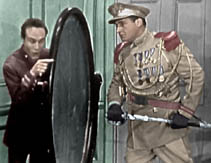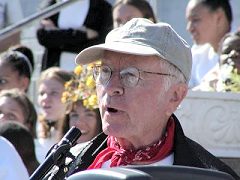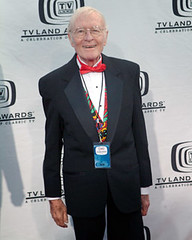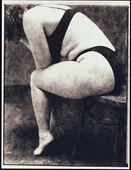 NOTE TO TV LAND EXECUTIVES: Bewitched
NOTE TO TV LAND EXECUTIVES: Bewitched was a TV SHOW and should not be confused with a tragic episode in American history. And yes, I do have a sense of humor.
The geniuses at TV Land have decided to erect a statue of Samantha Stephens -- the lead character in the hit television comedy of the 1960s and 70s,
Bewitched --in Salem, Massachusetts. She'll be sitting on a broom, sailing in front a crescent moon. Cool. But not in Salem. Please. I am probably the biggest fan of the lovely and graceful Elizabeth Montgomery, but she's got no business being immortalized in bronze in the hometown of Puritan persecution.
TV Land has put up several of these statues around the country: Mary Richards (aka Tyler Moore) is memorialized in Minneapolis throwing her hat up in the air, Jackie Gleason as Ralph Kramden of
The Honeymooners is displayed outside the Port Authority Bus Station in New York City even though he was from Brooklyn, and Andy Taylor (aka Griffith) and Ron Howard (Opie) are set up in Raleigh, N.C. But
Bewitched has about as much in common with Salem as
Get Smart does with the Bay of Pigs.
In a desperate ratings grab for viewers late in its run,
Bewitched actually went on location to Salem to film a couple of episodes and the best they could come up with was a lame story line about an enchanted bed warmer that became attached to Samantha while she toured the city. Even at the age of ten, I thought it was a stretch to find a connection between
Bewitched and the Salem scandals. I mean, wouldn't Samantha be a little shaken up by such a trip? Like a Japanese-American internee returning to Manzanar or a Native American visiting Wounded Knee or the Trail of Tears?
It is no mere coincidence that this statue is scheduled to go up around the same time the new
Bewitched film is scheduled to open. This kind of national movie promotion is not unusual. Those controversial stone displays of The Ten Commandments in front of so many government buildings across the country were actually presented as gifts from the producers of the 1950s Cecil B. DeMille epic. While the Religious Right have used those monuments as sites to test the separation of church and state, they originally embodied the melding of corporate and government interests.
Now, I am no humbug to marketing. I am a proud consumer, tourist, and television watcher. When I was a kid, my brother and I had a blast at some sort of Bedrock-themed amusement park that celebrated
The Flintstones and I've returned to both Disneyland and Disney World as an adult. My standards are not that high. I mean I watch
Entertainment Tonight for god's sake. But before we make too light of a very heavy event, it might be good to re-visit the facts.
In 1692, some of Salem's most paranoid and jealous residents found a convenient way to knock off their neighbors in order to grab their land or to simply to get them out of their hair. Teenage hysteria and an insecure pastor who couldn't get along with anyone added to the confusion, resulting in dozens of innocent people being hanged and one pressed to death under stones. Blameless and vulnerable residents lost their lives and reputations to satisfy the greed and neurosis of their neighbors -- and their descendents have certainly not forgotten the cost of the insanity. The miscarriage of justice was found to be so egregious that even some of the judges called in for the trials (one of them an ancestor of author Nathaniel Hawthorne), with the benefit of hindsight, denounced what had happened and, when possible, made small reparations to the survivors.
This cycle of history has repeated itself too many times as Arthur Miller pointed out by setting his story of McCarthyism,
The Crucible, during the Salem trials. J. Edgar Hoover carried out character assassination and incarceration throughout the 20th century with the Palmer Raids of the 1920s, the "witch hunts" after World War II, and FBI infiltration of protest groups in the 1960s. Depending on the social and political climate, it is easy for Americans to regress to superstitious Puritans, allowing religious principles and hysteria to dominate their judgement instead of the Constitution and Bill of Rights. If we are to remember how dangerous such behavior can be, we must protect the true story of what happened in Salem and not allow it turn into a sitcom version of reality. Samantha Stephens lived in Connecticut -- why not set her statue there? If Salem seems appropriate to TV Land, I suppose it won't be long before we see Redd Foxx from
Sanford and Son in downtown Selma or Birmingham or maybe Freddie Prinze from
Chico and the Man posed next to the Alamo.
TV Land executives and the mayor of Salem think the statue is a "fun" idea and will add to the tourism appeal of Salem. I don't want to be a spoilsport, but can we just halt the marketing machine for a minute and show a little respect when it's called for? The victims of Salem deserve to have their stories remembered as they actually happened. I promise I will still visit Salem, but I won't be looking for Samantha, just some honest history.
 I knew this day would come, but I didn't want to face it. Howard Morris is dead. He was crazy Ernest T. Bass on the "The Andy Griffith" show and gave one of the most fearless performances I've ever seen. In only 5 episodes, he created an indelible persona as tough and wiry as an overcooked chicken leg. If you want to know more about how "Howie" came up with this classic nutcase, you gotta go to the Ernest T. web site…it's precious insight from an actor who appeared goofy on the outside but who took his work very seriously.
I knew this day would come, but I didn't want to face it. Howard Morris is dead. He was crazy Ernest T. Bass on the "The Andy Griffith" show and gave one of the most fearless performances I've ever seen. In only 5 episodes, he created an indelible persona as tough and wiry as an overcooked chicken leg. If you want to know more about how "Howie" came up with this classic nutcase, you gotta go to the Ernest T. web site…it's precious insight from an actor who appeared goofy on the outside but who took his work very seriously. I didn't realize how great he was until I watched some reruns of "Your Show of Shows" and there he was: as the German general's assistant, a member of the spoofed 1950s musical group "The Haircuts", as a stuffed suit board member acting shocked at Sid Caesar's outrageous antics. He could do it all and underneath his performances were sparks of madness and a really nice guy.
I didn't realize how great he was until I watched some reruns of "Your Show of Shows" and there he was: as the German general's assistant, a member of the spoofed 1950s musical group "The Haircuts", as a stuffed suit board member acting shocked at Sid Caesar's outrageous antics. He could do it all and underneath his performances were sparks of madness and a really nice guy.  As a cartoon fan, I heard his voice in lots of commercials, "The Jetsons" and "The Archie Show." Even Qantas Airlines is paying tribute to Howard this week. He was the voice of the koala bear who hated Qantas for bringing all the tourists to Australia.
As a cartoon fan, I heard his voice in lots of commercials, "The Jetsons" and "The Archie Show." Even Qantas Airlines is paying tribute to Howard this week. He was the voice of the koala bear who hated Qantas for bringing all the tourists to Australia. I think everybody has one or two performers in their lifetime who they become curious about. Although I never wrote Howard Morris for an autograph or attended an Andy Griffith Show reunion, I continuously sought out other Ernest T. fans and I regularly checked the internet to see what he had done lately. In the meantime, my mom and I could always crack each other up doing Ernest T. imitations.
I think everybody has one or two performers in their lifetime who they become curious about. Although I never wrote Howard Morris for an autograph or attended an Andy Griffith Show reunion, I continuously sought out other Ernest T. fans and I regularly checked the internet to see what he had done lately. In the meantime, my mom and I could always crack each other up doing Ernest T. imitations.  I can't really add anything interesting to the obituaries and tributes that have already been written. Except I have to say that the fact that he was married and divorced FIVE TIMES says a lot about his tenacity when it came to women and romance. He was a chameleon who started in show biz early, worked hard and achieved popular success. He showed flashes of brilliance and I'm just really glad Howard Morris was in this world. And I'm equally sorry he's gone. Thank goodness for reruns and sweet memories.
I can't really add anything interesting to the obituaries and tributes that have already been written. Except I have to say that the fact that he was married and divorced FIVE TIMES says a lot about his tenacity when it came to women and romance. He was a chameleon who started in show biz early, worked hard and achieved popular success. He showed flashes of brilliance and I'm just really glad Howard Morris was in this world. And I'm equally sorry he's gone. Thank goodness for reruns and sweet memories. What the hell happened to the women's movement? Jesus, every time I turn around, there's a white male telling me what to do with my body OR making sure I stay in my place. What is this? 1959? I swear, the 21st century is starting to sound like the "end of days" for womens' rights: appointment of right wing judges, erosion of abortion rights, denial of prescriptions for birth control, women voting for George Bush. Who needs to see the Four Horsemen of the Apocalypse coming over the hill when you hear the President of Harvard questioning women's aptitude for math and science? Where have you gone, Betty Friedan and Gloria Steinem?
What the hell happened to the women's movement? Jesus, every time I turn around, there's a white male telling me what to do with my body OR making sure I stay in my place. What is this? 1959? I swear, the 21st century is starting to sound like the "end of days" for womens' rights: appointment of right wing judges, erosion of abortion rights, denial of prescriptions for birth control, women voting for George Bush. Who needs to see the Four Horsemen of the Apocalypse coming over the hill when you hear the President of Harvard questioning women's aptitude for math and science? Where have you gone, Betty Friedan and Gloria Steinem? Decades after Margaret Sanger smuggled diaphragms to America from England in empty whiskey bottles, I wonder what she would say if she knew that in my hometown in Eastern Washington, women who need an abortion must travel at least 200 miles. Abortion may not be illegal but without access (bus fare, a car), what's the difference? Isn't justice delayed the same as justice denied, especially when it comes to terminating a pregnancy? Sanger devoted her life to educating women about their bodies and increasing their access to medical care. A woman's right to plan her own family was a fundamental one for Sanger, but the same male-dominated institutions who fought Sanger are still trying to control the lives of women -- in and out of the bedroom.
Decades after Margaret Sanger smuggled diaphragms to America from England in empty whiskey bottles, I wonder what she would say if she knew that in my hometown in Eastern Washington, women who need an abortion must travel at least 200 miles. Abortion may not be illegal but without access (bus fare, a car), what's the difference? Isn't justice delayed the same as justice denied, especially when it comes to terminating a pregnancy? Sanger devoted her life to educating women about their bodies and increasing their access to medical care. A woman's right to plan her own family was a fundamental one for Sanger, but the same male-dominated institutions who fought Sanger are still trying to control the lives of women -- in and out of the bedroom.  In her novel, "The Handmaid's Tale," author Margaret Atwood warned us that women's rights can only be maintained if we are vigilant about protecting them. We have to become our own Gloria Steinems and Betty Friedans. Generations of women have come of age without knowing what it's like to live without birth control, Title IX, and the Office of Civil Rights. I once interviewed a local community leader who fought the attempt to shut down abortion services in my hometown. She told me she was done working on this issue. "It's a young woman's fight now," she said. If there are plenty more where she came from, those of us 40-somethings and the youngsters following close behind better get busy. White males are lining up to return to a "good old days" that never really existed and, unless we raise our voices and our consciousnesses, we might get dragged down with them.
In her novel, "The Handmaid's Tale," author Margaret Atwood warned us that women's rights can only be maintained if we are vigilant about protecting them. We have to become our own Gloria Steinems and Betty Friedans. Generations of women have come of age without knowing what it's like to live without birth control, Title IX, and the Office of Civil Rights. I once interviewed a local community leader who fought the attempt to shut down abortion services in my hometown. She told me she was done working on this issue. "It's a young woman's fight now," she said. If there are plenty more where she came from, those of us 40-somethings and the youngsters following close behind better get busy. White males are lining up to return to a "good old days" that never really existed and, unless we raise our voices and our consciousnesses, we might get dragged down with them.
 My battle with weight goes WAAAAAY back, starting with a fat childhood, ups and downs through adolescence and college, and eventually maintaining a normal weight for the past 15 years (although, as Dr. Phil would say, I did a lot of "white knuckle" dieting to maintain it). Lately, I've gained a lot of weight fast (see previous blog entry "Working the Night Shift") and boy, am I conflicted. Part of me wants to jump on this like a Master's Thesis: research it, study it, plan it, edit it, present it brilliantly, and emerge victorious. The other part of me wants to take a break from worrying about my size for a while and find satisfaction in something more "important." But can you really focus on something else when you feel so undeserving and disappointed inside? And is there anything more important than establishing a healthy relationship with your body?
My battle with weight goes WAAAAAY back, starting with a fat childhood, ups and downs through adolescence and college, and eventually maintaining a normal weight for the past 15 years (although, as Dr. Phil would say, I did a lot of "white knuckle" dieting to maintain it). Lately, I've gained a lot of weight fast (see previous blog entry "Working the Night Shift") and boy, am I conflicted. Part of me wants to jump on this like a Master's Thesis: research it, study it, plan it, edit it, present it brilliantly, and emerge victorious. The other part of me wants to take a break from worrying about my size for a while and find satisfaction in something more "important." But can you really focus on something else when you feel so undeserving and disappointed inside? And is there anything more important than establishing a healthy relationship with your body? Like most of life's challenges, fighting fat teaches you lessons about much more than the lard on your butt. It's not been fun to walk around with these extra pounds lately. It's like living in a padded shell with no hope. For a while, I got to feel "normal" and sometimes even superior because I could maintain a normal weight, but as the rest of the country gets fatter, I'm finding myself joining them. We're all getting older, slowing down, and eating more, and the solution to that equation is bigger bodies and buying your clothes in sizes that begin and end in "X".
Like most of life's challenges, fighting fat teaches you lessons about much more than the lard on your butt. It's not been fun to walk around with these extra pounds lately. It's like living in a padded shell with no hope. For a while, I got to feel "normal" and sometimes even superior because I could maintain a normal weight, but as the rest of the country gets fatter, I'm finding myself joining them. We're all getting older, slowing down, and eating more, and the solution to that equation is bigger bodies and buying your clothes in sizes that begin and end in "X". So, I am once again carrying too many pounds around with me in the world and I am trying to figure out why I feel the need to bring them along. The additional pounds also come with burdensome thoughts that threaten to keep me hidden. Here are some demons I'm wrestling with now:
So, I am once again carrying too many pounds around with me in the world and I am trying to figure out why I feel the need to bring them along. The additional pounds also come with burdensome thoughts that threaten to keep me hidden. Here are some demons I'm wrestling with now: There ain't a much more discouraging thing for a high school English teacher than to share a fabulous piece of literature with students, only to be met with stares, yawns, and befuddlement. Dirty jokes from Shakespeare, eternal truth from Homer, vicious social satire from Twain, all soaring over their heads like a private plane wandering in restricted air space. Talk about casting pearls before swine.
There ain't a much more discouraging thing for a high school English teacher than to share a fabulous piece of literature with students, only to be met with stares, yawns, and befuddlement. Dirty jokes from Shakespeare, eternal truth from Homer, vicious social satire from Twain, all soaring over their heads like a private plane wandering in restricted air space. Talk about casting pearls before swine. So, all of this is a long damn way to tell you about Dorothy Parker. Even at the end of the 20th century, I had to stray from the plethora of male writers and find female voices to balance their perspectives. That's when I wandered into the fabulous Mrs. Parker. What a woman. When admiring "the best" in any field, it's too easy to overlook their humanity and place them atop an unreachable pedestal. But Dorothy Parker won't hear of it. Even the brilliance of her writing doesn't blind you to her frailty. Affairs with married men, heavy drinking, marriage(s) to a homosexual, multiple suicide attempts; she lived it all and she filled pages with it. If you think the 20s were always roaring, try reading "The Big Blonde" and find out what it really meant to be a woman in America then: dependent, distorted, and despairing. She suffered through the bullshit of Hollywood, was an unabashed leftist, opposed Nazism and Fascism, reported on the Spanish Civil War, and was blacklisted during the McCarthy era. Toward the end of her life, she lived in hotels and carried little dogs around that crapped wherever they wanted and when she died, she left her estate to Martin Luther King, Jr. Now, THAT is an interesting life story.
So, all of this is a long damn way to tell you about Dorothy Parker. Even at the end of the 20th century, I had to stray from the plethora of male writers and find female voices to balance their perspectives. That's when I wandered into the fabulous Mrs. Parker. What a woman. When admiring "the best" in any field, it's too easy to overlook their humanity and place them atop an unreachable pedestal. But Dorothy Parker won't hear of it. Even the brilliance of her writing doesn't blind you to her frailty. Affairs with married men, heavy drinking, marriage(s) to a homosexual, multiple suicide attempts; she lived it all and she filled pages with it. If you think the 20s were always roaring, try reading "The Big Blonde" and find out what it really meant to be a woman in America then: dependent, distorted, and despairing. She suffered through the bullshit of Hollywood, was an unabashed leftist, opposed Nazism and Fascism, reported on the Spanish Civil War, and was blacklisted during the McCarthy era. Toward the end of her life, she lived in hotels and carried little dogs around that crapped wherever they wanted and when she died, she left her estate to Martin Luther King, Jr. Now, THAT is an interesting life story. Regardless of the mixed success of those years of teaching, I still remember them happily. Even now, when I get excited about a new writer or story, I run through the mental exercise of figuring out the best way to share it with students. Then I realize I don't have to do that anymore. I can just sit and enjoy the story or excitement of a new author. So, I stepped back in time when I recently ordered the works of the fabulous Mrs. Parker on audio CD for my commute. Aaaaaaahhhh…. It's a selfish joy to sit and listen and not worry about who else "gets" it. She's unbelievable: the subtlety and craft of her short story "The Game," theater criticism that sounds like it was written yesterday, her hilarious monologue, "A Little One." They are absolute magic. I hope that at least one of my former students will enjoy her one day like I do. In the meantime, there's not much better company than the fabulous Mrs. Parker -- whether you are curled up in big stuffed chair, listening to a car stereo, or sitting in a classroom.
Regardless of the mixed success of those years of teaching, I still remember them happily. Even now, when I get excited about a new writer or story, I run through the mental exercise of figuring out the best way to share it with students. Then I realize I don't have to do that anymore. I can just sit and enjoy the story or excitement of a new author. So, I stepped back in time when I recently ordered the works of the fabulous Mrs. Parker on audio CD for my commute. Aaaaaaahhhh…. It's a selfish joy to sit and listen and not worry about who else "gets" it. She's unbelievable: the subtlety and craft of her short story "The Game," theater criticism that sounds like it was written yesterday, her hilarious monologue, "A Little One." They are absolute magic. I hope that at least one of my former students will enjoy her one day like I do. In the meantime, there's not much better company than the fabulous Mrs. Parker -- whether you are curled up in big stuffed chair, listening to a car stereo, or sitting in a classroom.
 I've been trying to attend a certain "How to Audition for Musical Theater" workshop for three years now and I finally made it last night. The hosts were the artistic staff of Seattle's
I've been trying to attend a certain "How to Audition for Musical Theater" workshop for three years now and I finally made it last night. The hosts were the artistic staff of Seattle's 
 Recently I had lunch with a high school buddy I hadn't seen in 15 years (15 YEARS!). She looked so great. I think we were both worried that we would have turned into homely middle-aged schlubs wearing spandex leggings, oversized sweatshirts, and hair that hadn't been cut or colored in a decade. Luckily, it didn't turn out that way.
Recently I had lunch with a high school buddy I hadn't seen in 15 years (15 YEARS!). She looked so great. I think we were both worried that we would have turned into homely middle-aged schlubs wearing spandex leggings, oversized sweatshirts, and hair that hadn't been cut or colored in a decade. Luckily, it didn't turn out that way. But plenty of lesbians could go "mano a mano" with me comparing dreadful man tales. What else could it be? OK, I had a mullet for awhile in the mid-1980s and I usually wear short hair, but that's not gay, that's just low maintenance. I have a tendency to be overweight but I don't particularly like trucks, softball, or Home Depot. Even though I have been "embracing my girly side" a lot lately, there are probably many lesbians who could say the same thing. So, what else?
But plenty of lesbians could go "mano a mano" with me comparing dreadful man tales. What else could it be? OK, I had a mullet for awhile in the mid-1980s and I usually wear short hair, but that's not gay, that's just low maintenance. I have a tendency to be overweight but I don't particularly like trucks, softball, or Home Depot. Even though I have been "embracing my girly side" a lot lately, there are probably many lesbians who could say the same thing. So, what else? I better be honest -- with you and myself, I am a little gay. (If you don't believe me, look at my earlier entry about Nigella Lawson). There have been many times when I have entertained the idea of experimenting. In fact, during my 20s, I wondered if I was, indeed, gay. I once snuck a peek at a friend's journal and she was asking herself the same question. Personally, the peak of my lesbian career took place 20 years ago in a bathroom stall on Capitol Hill when I drunkenly scribbled a note on the wall for anyone interested in "trying something new." No one ever did. Or else they didn't call me if they did. When I sobered up, I spent a few nervous weeks worried they might.
I better be honest -- with you and myself, I am a little gay. (If you don't believe me, look at my earlier entry about Nigella Lawson). There have been many times when I have entertained the idea of experimenting. In fact, during my 20s, I wondered if I was, indeed, gay. I once snuck a peek at a friend's journal and she was asking herself the same question. Personally, the peak of my lesbian career took place 20 years ago in a bathroom stall on Capitol Hill when I drunkenly scribbled a note on the wall for anyone interested in "trying something new." No one ever did. Or else they didn't call me if they did. When I sobered up, I spent a few nervous weeks worried they might. So, the folks who told my friend I'm gay didn't get it exactly wrong or exactly right. I've never acted on my gay impulses, but that doesn't mean I don't have them. I'm glad I had them. They made me a more complete person. I feel a little sad for those (especially men) who are so bound by homophobia that they never let their minds and bodies consider what it's like on the other side of the fence -- even for a minute. Without giving full expression to all of our impulses, we choke an important part of ourselves and then we turn into Spokane mayor
So, the folks who told my friend I'm gay didn't get it exactly wrong or exactly right. I've never acted on my gay impulses, but that doesn't mean I don't have them. I'm glad I had them. They made me a more complete person. I feel a little sad for those (especially men) who are so bound by homophobia that they never let their minds and bodies consider what it's like on the other side of the fence -- even for a minute. Without giving full expression to all of our impulses, we choke an important part of ourselves and then we turn into Spokane mayor  There's a new book out from an author named Steven Johnson that makes the case for popular culture making us SMARTER. Thus, nullifying all those old grumps who complain about "you kids and your new-fangled au-to-MO-beels."
There's a new book out from an author named Steven Johnson that makes the case for popular culture making us SMARTER. Thus, nullifying all those old grumps who complain about "you kids and your new-fangled au-to-MO-beels."  One of my favorite books right now is "Freakonomics" -- it's a brilliant spin on otherwise mundane topics. The KKK chapter alone is worth the price of the book. You don't have to be an economics nerd to enjoy it. Perfect at the gym or at bedtime...and there's even more AMAZING news! "Freakonomics" is featured on a blog!
One of my favorite books right now is "Freakonomics" -- it's a brilliant spin on otherwise mundane topics. The KKK chapter alone is worth the price of the book. You don't have to be an economics nerd to enjoy it. Perfect at the gym or at bedtime...and there's even more AMAZING news! "Freakonomics" is featured on a blog! 

 I love to find out how couples met for the first time. It makes me pretty popular at parties. No matter how deadly boring the conversation might be, people light up like fireworks when you ask them about the big "bing" moment. Sometimes it's just like the song: "There were bells on the hill but I never heard them ringing….'til there was you." And sometimes it's slow and gradual like the bass line in a Barry White ballad. The best stories are a result of total fluke-y luck or some kind of surprise beginning (like they hated each other for a year before they hit the sack). No matter what, every story is different and usually highly entertaining, if not in content, at least in style.
I love to find out how couples met for the first time. It makes me pretty popular at parties. No matter how deadly boring the conversation might be, people light up like fireworks when you ask them about the big "bing" moment. Sometimes it's just like the song: "There were bells on the hill but I never heard them ringing….'til there was you." And sometimes it's slow and gradual like the bass line in a Barry White ballad. The best stories are a result of total fluke-y luck or some kind of surprise beginning (like they hated each other for a year before they hit the sack). No matter what, every story is different and usually highly entertaining, if not in content, at least in style. Advice-givers say if you are looking for a compatible partner, you should stop LOOKING and start participating in activities you love. The theory being you will find a better partner if you share the same interests. This has some merit even though the outside world can overshadow your shared passion. I met a potential partner in a Latin American History class, but once "real life" started, the damage created by his emotional politics far outweighed any military junta and we struggled for two loooooooong fucked-up years. I'm hoping for a better future for Rob and Amber once the reality TV cameras fade to black.
Advice-givers say if you are looking for a compatible partner, you should stop LOOKING and start participating in activities you love. The theory being you will find a better partner if you share the same interests. This has some merit even though the outside world can overshadow your shared passion. I met a potential partner in a Latin American History class, but once "real life" started, the damage created by his emotional politics far outweighed any military junta and we struggled for two loooooooong fucked-up years. I'm hoping for a better future for Rob and Amber once the reality TV cameras fade to black. Bottom line, meeting someone at a bar is really no better or worse than any other method. Millions of college students can't be wrong. The ones in my neighborhood keep the tradition alive by lining up for hours in front of the hottest local singles scenes (karaoke, live grand piano duos). They have a couple of factors in their favor: volume and tradition. The sheer numbers involved naturally increase the probability of finding someone interesting and booze is a tried-and-true social lubricant. Nothing like a glass of something to a) give you something to do with your hands 2) provide a conversation topic and 3) boost your confidence while blurring your judgemental side.
Bottom line, meeting someone at a bar is really no better or worse than any other method. Millions of college students can't be wrong. The ones in my neighborhood keep the tradition alive by lining up for hours in front of the hottest local singles scenes (karaoke, live grand piano duos). They have a couple of factors in their favor: volume and tradition. The sheer numbers involved naturally increase the probability of finding someone interesting and booze is a tried-and-true social lubricant. Nothing like a glass of something to a) give you something to do with your hands 2) provide a conversation topic and 3) boost your confidence while blurring your judgemental side. It seems that since Condoleeza Rice stepped in as Secretary of State, the U.S. has gotten a little squeamish about using the term "genocide" when referring to what's going on in Darfur, Sudan in Africa. That's understandable when even our President parses the meaning of the word "is," but in a century where we named the unspeakable and promised "never again," our words are erasing the reality of what's happening in Africa.
It seems that since Condoleeza Rice stepped in as Secretary of State, the U.S. has gotten a little squeamish about using the term "genocide" when referring to what's going on in Darfur, Sudan in Africa. That's understandable when even our President parses the meaning of the word "is," but in a century where we named the unspeakable and promised "never again," our words are erasing the reality of what's happening in Africa. We're almost halfway there in Darfur: over the past two years, 300,000 Sudanese have been killed through slaughter and starvation by their own government. Women are being raped, families are being displaced, and entire villages of farmers are being razed. Now that we seem to have an active policy of using military force against governments who terrorize their own citizens, why don't we lead some forces into Sudan?
We're almost halfway there in Darfur: over the past two years, 300,000 Sudanese have been killed through slaughter and starvation by their own government. Women are being raped, families are being displaced, and entire villages of farmers are being razed. Now that we seem to have an active policy of using military force against governments who terrorize their own citizens, why don't we lead some forces into Sudan?  The most productive effort I have seen is happening in Newton, Massachusetts where
The most productive effort I have seen is happening in Newton, Massachusetts where  NOTE TO TV LAND EXECUTIVES: Bewitched was a TV SHOW and should not be confused with a tragic episode in American history. And yes, I do have a sense of humor.
NOTE TO TV LAND EXECUTIVES: Bewitched was a TV SHOW and should not be confused with a tragic episode in American history. And yes, I do have a sense of humor.


